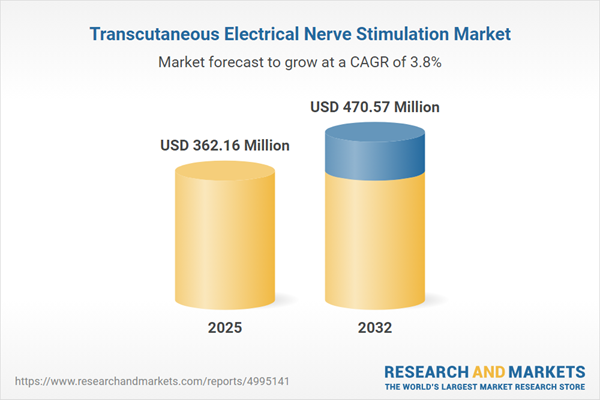Speak directly to the analyst to clarify any post sales queries you may have.
The transcutaneous electrical nerve stimulation (TENS) market is advancing rapidly as providers and stakeholders seek more effective, scalable, and technology-driven pain management solutions in clinical and home-based environments.
Market Snapshot: Global TENS Market Growth and Trends
The global TENS market is benefiting from sustained growth and increasing interest from healthcare organizations in alternatives to pharmaceutical pain relief. With continuous technical evolution, TENS solutions are now integral to a broad spectrum of care—from outpatient rehabilitation to specialized clinical programs. Healthcare leaders recognize the benefits of advanced nerve and muscle stimulation, observing alignment with new clinical pathways and regulatory standards. Meanwhile, regulatory frameworks and patient expectations continue shaping the next generation of feature-rich and portable systems, enabling flexible use in both professional and home-based care. The expanding market is also influenced by strategic partnerships and tailored distribution models, helping organizations meet the needs of established regions and capitalize on emerging market opportunities.
Scope & Segmentation in the TENS Market
In-depth segmentation within the TENS market provides clarity for senior executives directing technology investments and future-proofing their care delivery strategies. The market’s core segments reveal where business and innovation converge:
- Product Types: Portable TENS units support therapy beyond healthcare facilities, increasing access for outpatient and in-home applications, while stationary devices are designed for consistent use within professional clinical settings.
- Mode: TENS devices deliver various therapies, such as acupuncture, burst, conventional, and modulated stimulation, meeting diverse organizational protocols and supporting wide-ranging patient requirements.
- Battery Types: Organizations select between disposable and rechargeable batteries, optimizing for sustainability, reliability, and streamlined long-term device management.
- Applications: TENS technology spans acute pain management, chronic pain relief, nerve disorder therapy, post-injury rehabilitation, sports medicine, and increasingly, therapeutic aesthetics—broadening the clinical value and appeal for healthcare stakeholders.
- End User: Adoption is observed across hospitals, specialty clinics, physiotherapy centers, and residential care providers, all seeking wider pain management coverage and enhanced support for at-home patient recovery.
- Geographical Regions: North America leads adoption, especially in the United States and Canada, while Europe, the Asia-Pacific, Middle East, and Africa demonstrate significant momentum, reflecting new regulations and rising standards of care.
- Leading Industry Participants: Key influence originates from Medtronic plc, DJO Global, ConMed Corporation, Omron Healthcare, Zynex, BTL Industries, NeuroMetrix, CeFAR AB, BioMedical Life Systems, and Enraf Nonius, who help define technology benchmarks and expand market access worldwide.
Key Takeaways for Senior Decision-Makers
- Connected TENS platforms are extending clinical reach and strengthening virtual pain management, accelerating provider response and allowing patients to participate more actively in care.
- Integrated device software generates timely patient data, transforming workflow efficiency and supporting rapid, evidence-driven clinical decisions for practitioners and healthcare managers.
- Strong regulatory and reimbursement planning are essential to maintaining organizational responsiveness and navigating continually evolving access conditions within the market.
- Emerging features such as multi-mode waveforms and versatile battery solutions make TENS platforms a valuable asset for rehabilitation programs, sports recovery, and innovative aesthetic therapies.
- Industry collaboration contributes to the standardization of device technologies, increases product variety, and amplifies confidence in the overall reliability of medical equipment across networks.
- Mergers and acquisitions remain pivotal in sharpening organizational adaptability and sustaining relevance during shifts in the global medical device sector.
Tariff Impact on the TENS Market
Recent United States tariffs on medical device imports have compelled TENS manufacturers and providers to review their supply chains. In response, organizations are adopting adjusted pricing strategies and boosting domestic industry partnerships, driving continued compliance and competitive positioning throughout the sector.
Methodology & Data Sources
This analysis is grounded in direct interviews with healthcare executives and clinical end users, as well as the latest regulatory reviews. Evidence-based recommendations are further supported by SWOT analysis and Porter’s Five Forces to ensure actionable insight for TENS stakeholders.
Why This Report Matters
- Supplies senior executives with data-driven segmentation, refining device-based pain management strategy and supporting long-term technology planning.
- Delivers transparent regional and investment trend analysis for targeted operational and capital planning.
- Empowers organizations to adapt confidently to regulatory changes and maintain ongoing enhancements in patient care quality.
Conclusion
With digital innovation and adaptability shaping the TENS sector, this report provides senior leaders with actionable intelligence to inform future strategies and capitalize on evolving market opportunities.
Additional Product Information:
- Purchase of this report includes 1 year online access with quarterly updates.
- This report can be updated on request. Please contact our Customer Experience team using the Ask a Question widget on our website.
Table of Contents
3. Executive Summary
4. Market Overview
7. Cumulative Impact of Artificial Intelligence 2025
Companies Mentioned
The companies profiled in this Transcutaneous Electrical Nerve Stimulation market report include:- Medtronic plc
- DJO Global, Inc.
- ConMed Corporation
- Omron Healthcare Co., Ltd.
- Zynex, Inc.
- BTL Industries d.o.o.
- NeuroMetrix, Inc.
- CeFAR AB
- BioMedical Life Systems, Inc.
- Enraf Nonius B.V.
Table Information
| Report Attribute | Details |
|---|---|
| No. of Pages | 198 |
| Published | October 2025 |
| Forecast Period | 2025 - 2032 |
| Estimated Market Value ( USD | $ 362.16 Million |
| Forecasted Market Value ( USD | $ 470.57 Million |
| Compound Annual Growth Rate | 3.8% |
| Regions Covered | Global |
| No. of Companies Mentioned | 11 |









